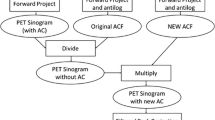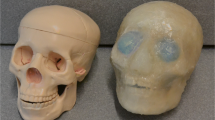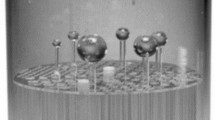Abstract
Attenuation correction (AC) is essential for quantitative positron emission tomography (PET) images. Attenuation coefficient maps (μ-maps) are usually generated from computed tomography (CT) images when PET-CT combined systems are used. If CT has been performed prior to PET imaging, pre-acquired CT can be used for brain PET AC, because the human head is almost rigid. This pre-acquired CT-based AC approach is suitable for stand-alone brain-dedicated PET, such as VRAIN (ATOX Co. Ltd., Tokyo, Japan). However, the headrest of PET is different from the headrest in pre-acquired CT images, which may degrade the PET image quality. In this study, we prepared three different types of μ-maps: (1) based on the pre-acquired CT, where namely the headrest is different from the PET system (μ-map-diffHr); (2) manually removing the headrest from the pre-acquired CT (μ-map-noHr); and (3) artificially replacing the headrest region with the headrest of the PET system (μ-map-sameHr). Phantom images by VRAIN using each μ-map were investigated for uniformity, noise, and quantitative accuracy. Consequently, only the uniformity of the images using μ-map-diffHr was out of the acceptance criteria. We then proposed an automated method for removing the headrest from pre-acquired CT images. In comparisons of standardized uptake values in nine major brain regions from the 18F-fluoro-2-deoxy-D-glucose-PET of 10 healthy volunteers, no significant differences were found between the μ-map-noHr and the μ-map-sameHr. In conclusion, pre-acquired CT-based AC with automated headrest removal is useful for brain-dedicated PET such as VRAIN.






Similar content being viewed by others
References
Bailey DL. Transmission scanning in emission tomography. Eur J Nucl Med. 1998;25(7):774–87. https://doi.org/10.1007/S002590050282.
Kinahan PE, Hasegawa BH, Beyer T. X-ray-based attenuation correction for positron emission tomography/computed tomography scanners. Semin Nucl Med. 2003;33(3):166–79. https://doi.org/10.1053/SNUC.2003.127307.
Tashima H, Yamaya T. Proposed helmet PET geometries with add-on detectors for high sensitivity brain imaging. Phys Med Biol. 2016;61(19):7205–20. https://doi.org/10.1088/0031-9155/61/19/7205.
Watanabe M, et al. Performance evaluation of a high-resolution brain PET scanner using four-layer MPPC DOI detectors. Phys Med Biol. 2017;62(17):7148–66. https://doi.org/10.1088/1361-6560/AA82E8.
Yoshida E, et al. 245 ps-TOF brain-dedicated PET prototype with a hemispherical detector arrangement. Phys Med Biol. 2020. https://doi.org/10.1088/1361-6560/AB8C91.
Akamatsu G, et al. Performance evaluation of VRAIN: a brain-dedicated PET with a hemispherical detector arrangement. Phys Med Biol. 2022. https://doi.org/10.1088/1361-6560/ac9e87.
Takahashi M, Akamatsu G, Iwao Y, Tashima H, Yoshida E, Yamaya T. Small nuclei identification with a hemispherical brain PET. EJNMMI Phys. 2022;9(1):1–11. https://doi.org/10.1186/S40658-022-00498-4/TABLES/2.
Chen W. Clinical applications of PET in brain tumors. J Nucl Med. 2007;48(9):1468–81. https://doi.org/10.2967/JNUMED.106.037689.
Marinelli M, Positano V, Tucci F, Neglia D, Landini L. Automatic PET-CT image registration method based on mutual information and genetic algorithms. Sci World J. 2012;2012:12. https://doi.org/10.1100/2012/567067.
Maes F, Collignon A, Vandermeulen D, Marchal G, Suetens P. Multimodality image registration by maximization of mutual information. IEEE Trans Med Imaging. 1997;16(2):187–98. https://doi.org/10.1109/42.563664.
Tashima H, Akamatsu G, Yamashita T, Yamaya T. Scatter correction with image-domain interpolation for TOF helmet-type PET. IEEE NSS/MIC conference record 2021; 1–2.
Verwer EE, et al. Harmonisation of PET/CT contrast recovery performance for brain studies. doi: https://doi.org/10.1007/s00259-021-05201-w/Published.
Ikari Y, et al. Phantom criteria for qualification of brain FDG and amyloid PET across different cameras. EJNMMI Phys. 2016;3(1):1–18. https://doi.org/10.1186/S40658-016-0159-Y/TABLES/4.
Sankur B. Survey over image thresholding techniques and quantitative performance evaluation. J Electron Imaging. 2004;13(1):146. https://doi.org/10.1117/1.1631315.
Vandenberghe S, Marsden PK. PET-MRI: a review of challenges and solutions in the development of integrated multimodality imaging. Phys Med Biol. 2015;60(4):R115. https://doi.org/10.1088/0031-9155/60/4/R115.
Sunderland JJ, Christian PE. Quantitative PET/CT scanner performance characterization based upon the Society of Nuclear Medicine and Molecular Imaging Clinical Trials Network oncology clinical simulator phantom. J Nucl Med. 2023;56:145–52.
Scheuermann JS, Saffer JR, Karp JS, Levering AM, Siegel BA. Qualification of PET scanners for use in multicenter cancer clinical trials: the American College of Radiology Imaging Network experience. J Nucl Med. 2023;50:1187–93.
PET Amyloid Biomarker Committee. 18F-labeled PET tracers targeting amyloid as an imaging biomarker. Quantitative imaging biomarkers alliance. technically confirmed version. Jun 3, 2022. Available from; RSNA.ORG/QIBA
Ladefoged CN, et al. A multi-centre evaluation of eleven clinically feasible brain PET/MRI attenuation correction techniques using a large cohort of patients. Neuroimage. 2017;147:346–59. https://doi.org/10.1016/J.NEUROIMAGE.2016.12.010.
Liu F, Jang H, Kijowski R, Zhao G, Bradshaw T, McMillan AB. A deep learning approach for 18F-FDG PET attenuation correction. EJNMMI Phys. 2018;5(1):1–15. https://doi.org/10.1186/S40658-018-0225-8.
Dong X, et al. Synthetic CT generation from non-attenuation corrected PET images for whole-body PET imaging. Phys Med Biol. 2019. https://doi.org/10.1088/1361-6560/AB4EB7.
Lee JS. A review of deep-learning-based approaches for attenuation correction in positron emission tomography. IEEE Trans Radiat Plasma Med Sci. 2021;5(2):160–84. https://doi.org/10.1109/TRPMS.2020.3009269.
Rezaei A, Defrise M, Nuyts J. ML-reconstruction for TOF-PET with simultaneous estimation of the attenuation factors. IEEE Trans Med Imaging. 2014;33(7):1563–72. https://doi.org/10.1109/TMI.2014.2318175.
Chun SY, Kim KY, Lee JS, Fessier JA. Joint estimation of activity distribution and attenuation map for TOF-PET using alternating direction method of multiplier. Proceedings - International Symposium on Biomedical Imaging, 2016;pp. 86–89. doi: https://doi.org/10.1109/ISBI.2016.7493217.
Chilamkurthy S, et al. Development and validation of deep learning algorithms for detection of critical findings in head CT scans. 2018; Accessed: 13 Jun 2022. [Online]. Available: http://arxiv.org/abs/1803.05854
Boellaard R, Hofman MBM, Hoekstra OS, Lammertsma AA. Accurate PET/MR quantification using time-of-flight MLAA image reconstruction. Mol Imag Biol. 2014;16:469–77.
Rezaei A, et al. Simultaneous reconstruction of activity and attenuation in time-of-flight PET. IEEE Trans Med Imag. 2023;31:2224–33.
Lecoq P, et al. Roadmap toward the 10 ps time-of-flight PET challenge. Phys Med Biol. 2023;65:2101.
Author information
Authors and Affiliations
Corresponding authors
Ethics declarations
Conflict of interest
This clinical study was financially supported by ATOX Co., Ltd. (Tokyo, Japan).
Ethics approval
All the procedures performed in studies involving human participants were in accordance with the ethical standards of the institutional and/or national research committee and with the 1964 Helsinki Declaration and its later amendments or comparable ethical standards. This study was approved by the institutional review board of our institute and registered in the Japan Registry of Clinical Trials (jRCTs032210086).
Additional information
Publisher's Note
Springer Nature remains neutral with regard to jurisdictional claims in published maps and institutional affiliations.
Supplementary Information
Below is the link to the electronic supplementary material.
About this article
Cite this article
Iwao, Y., Akamatsu, G., Tashima, H. et al. Pre-acquired CT-based attenuation correction with automated headrest removal for a brain-dedicated PET system. Radiol Phys Technol 16, 552–559 (2023). https://doi.org/10.1007/s12194-023-00744-z
Received:
Revised:
Accepted:
Published:
Issue Date:
DOI: https://doi.org/10.1007/s12194-023-00744-z




